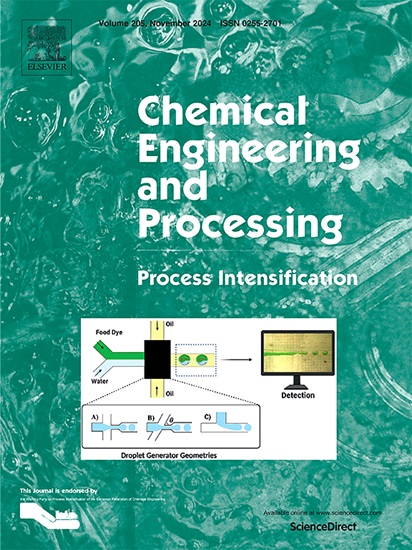在 K2CO3 活性生物炭上超声辅助吸附脱硫模型燃料中的二苯并噻吩
IF 3.8
3区 工程技术
Q3 ENERGY & FUELS
Chemical Engineering and Processing - Process Intensification
Pub Date : 2024-11-09
DOI:10.1016/j.cep.2024.110065
引用次数: 0
摘要
利用枣核和橄榄核的等量混合物开发了一种新型介孔活性生物炭(ABC),并将其用于模型汽油(300 ppm DBT/正己烷)和模型煤油(300 ppm DBT/环己烷)的超声辅助吸附脱硫(USADS)。生物废料混合物在 450 °C 下以 10 °C/min 的升温速率碳化 75 分钟,然后进行 K2CO3 活化。采用 1:1 的 K2CO3: 生物炭浸渍比例,在 750 °C 下合成了优质 ABC,时间为 1 小时。合成的 ABC 的 BET 表面积和平均孔径分别为 1099.70 m2/g 和 5.14 nm。两种模型的 USADS 都是在相对温和的实验条件下实现的(0.20 克 ABC 30 °C、40 分钟和 120 W US 功率)。在这些条件下,汽油模型的 USADS 为 97.32%,而煤油模型的 USADS 为 99.39%。两种模型的 USADS 过程都遵循吸附等温线的 Langmuir 模型和伪 2 阶动力学模型。在第 5 个再生周期之前,ABC 都是可回收和有效的,并且可以合理地重复使用。在 30 °C、120 分钟的条件下,使用 1.0 克的 ABC 可使实际汽油的 USADS 达到最大值(88.12%)。本文章由计算机程序翻译,如有差异,请以英文原文为准。
Ultrasound-assisted adsorptive desulfurization of dibenzothiophene from model fuel on K2CO3-activated biochar
A novel mesoporous activated biochar (ABC) was developed from an equal mix of date and olive stones and implemented in the ultrasound-assisted adsorptive desulfurization (USADS) of model gasoline (300 ppm DBT/n-hexane) and model kerosene (300 ppm DBT/cyclohexane). The biowaste blend was carbonized at 450 °C for 75 min at a 10 °C/min heating rate, followed by K2CO3-activation. The superior ABC was synthesized at 750 °C for 1 h using an impregnation ratio of 1:1 K2CO3: biochar. The BET surface area and average pore diameter of the resulting ABC were 1099.70 m2/g and 5.14 nm, respectively. The USADS of both models was achieved at relatively mild experimental conditions (0.20 g of the ABC 30 °C, 40 min, and 120 W US power). At these conditions, the USADS of model gasoline amounted to 97.32 % compared to 99.39 % for model kerosene. The USADS process of both models followed the Langmuir model of the adsorption isotherms and the pseudo-2nd-order kinetics model. The ABC was recoverable and effective until the 5th regeneration cycle and reused reasonably. The maximum USADS of real gasoline (88.12 %) was achieved using 1.0 g of the ABC at 30 °C for 120 min.
求助全文
通过发布文献求助,成功后即可免费获取论文全文。
去求助
来源期刊
CiteScore
7.80
自引率
9.30%
发文量
408
审稿时长
49 days
期刊介绍:
Chemical Engineering and Processing: Process Intensification is intended for practicing researchers in industry and academia, working in the field of Process Engineering and related to the subject of Process Intensification.Articles published in the Journal demonstrate how novel discoveries, developments and theories in the field of Process Engineering and in particular Process Intensification may be used for analysis and design of innovative equipment and processing methods with substantially improved sustainability, efficiency and environmental performance.

 求助内容:
求助内容: 应助结果提醒方式:
应助结果提醒方式:


